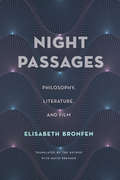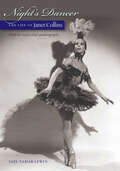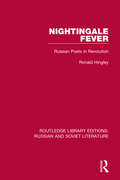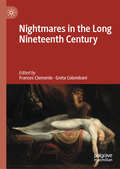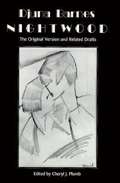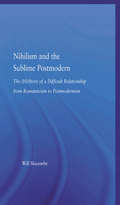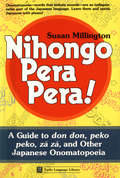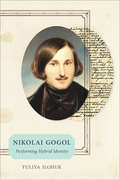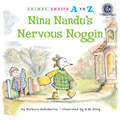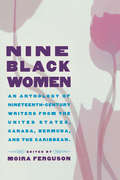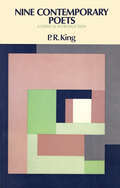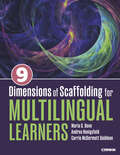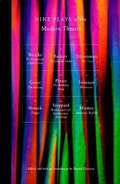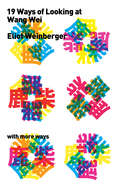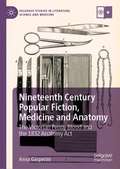- Table View
- List View
Night Passages: Philosophy, Literature, and Film
by Elisabeth BronfenIn the beginning was the night. All light, shapes, language, and subjective consciousness, as well as the world and art depicting them, emerged from this formless chaos. In fantasy, we seek to return to this original darkness. Particularly in literature, visual representations, and film, the night resiliently resurfaces from the margins of the knowable, acting as a stage and state of mind in which exceptional perceptions, discoveries, and decisions play out.Elisabeth Bronfen investigates the nocturnal spaces in which extraordinary events unfold, and casts a critical eye into the darkness that enables the irrational exploration of desire, transformation, ecstasy, transgression, spiritual illumination, and moral choice. She begins with an analysis of classical myths depicting the creation of the world and then moves through night scenes in Shakespeare and Milton, Gothic novels and novellas, Hegel's romantic philosophy, and Freud's psychoanalysis. Bronfen also demonstrates how modern works of literature and film, particularly film noir, can convey that piece of night the modern subject carries within. From Mozart's "Queen of the Night" to Virginia Woolf 's oscillation between day and night, life and death, and chaos and aesthetic form, Bronfen renders something visible, conceivable, and comprehensible from the dark realms of the unknown.
Night SparkNotes Literature Guide (SparkNotes Literature Guide Series #48)
by SparkNotesNight SparkNotes Literature Guide by Elie Wiesel Making the reading experience fun! When a paper is due, and dreaded exams loom, here's the lit-crit help students need to succeed! SparkNotes Literature Guides make studying smarter, better, and faster. They provide chapter-by-chapter analysis; explanations of key themes, motifs, and symbols; a review quiz; and essay topics. Lively and accessible, SparkNotes is perfect for late-night studying and paper writing. Includes:An A+ Essay—an actual literary essay written about the Spark-ed book—to show students how a paper should be written.16 pages devoted to writing a literary essay including: a glossary of literary termsStep-by-step tutoring on how to write a literary essayA feature on how not to plagiarize
Night's Dancer: The Life of Janet Collins
by Yaël Tamar LewinThe biography of the first African-American prima ballerinaWinner of the The Marfield Prize / National Award for Arts Writing (2011) Dancer Janet Collins, born in New Orleans in 1917 and raised in Los Angeles, soared high over the color line as the first African-American prima ballerina at the Metropolitan Opera. Night's Dancer chronicles the life of this extraordinary and elusive woman, who became a unique concert dance soloist as well as a black trailblazer in the white world of classical ballet. During her career, Collins endured an era in which racial bias prevailed, and subsequently prevented her from appearing in the South. Nonetheless, her brilliant performances transformed the way black dancers were viewed in ballet. The book begins with an unfinished memoir written by Collins in which she gives a captivating account of her childhood and young adult years, including her rejection by the Ballet Russe de Monte Carlo. Dance scholar Yaël Tamar Lewin then picks up the thread of Collins's story. Drawing on extensive research and interviews with Collins and her family, friends, and colleagues to explore Collins's development as a dancer, choreographer, and painter, Lewin gives us a profoundly moving portrait of an artist of indomitable spirit.
Nightingale Fever: Russian Poets in Revolution (Routledge Library Editions: Russian and Soviet Literature #7)
by Ronald HingleyThis book, first published in 1981, examines the dramatic and tragic stories of four of the greatest Russian poets of the twentieth century, their struggle to survive the Stalin years, and their dedication to their art despite considerable personal danger. Interweaving the stories of Anna Akhmatova, Osip Mandelstam, Boris Pasternak and Marina Tsvetayeva, the noted Russian scholar Ronald Hingley traces their education, the literary schools and traditions with which they were associated, the impact of World War I and the Bolshevik Revolution on their work, and the emergence of their distinct and disparate styles. He examines how the four influenced and affected each other – as colleague, critic or rival, friend or lover – and, as their fates were increasingly caught up in the aftermath of the Russian Revolution, how they came to depend on each other for solace and refuge. This book makes vivid the historic conflict between artists and political authority, and shows how they came into conflict with the Stalinist totalitarian regime intent on their destruction. Ronald Hingley’s brilliant narrative and superb translations of many of the major poems give us a haunting story of artistic achievement and heroic resistance.
Nightmare Mode: A Boss Fight Books Anthology (Boss Fight Books)
by Boss Fight BooksSo you've managed to best our most fearsome books? Well gear up, brave adventurer: It's time for some DLC. Boss Fight&’s authors have done so much great writing you won&’t find in their books, so we decided to put together our very own B-sides & rarities compilation: Nightmare Mode. In this anthology you&’ll delve into lost chapters and timely essays in which Boss Fight authors return to the games and series that inspired their full-length titles. Inside you&’ll encounter: David L. Craddock on how Shovel Knight's developers collaborated with speedrunners, Alexa Ray Corriea on the characters and themes in Kingdom Hearts III, Alyse Knorr on how Princess Peach&’s story draws on 2000 years of women in peril, Alex Kane interviews the man behind Star Wars Battlefront II's use of motion capture technology, Salvatore Pane on the fan projects that have kept the Mega Man series alive, Philip J Reed interviews S.D. Perry about her beloved Resident Evil novels, Gabe Durham on how Zelda's fandom influenced the official Zelda timeline, Jon Irwin savors the anticipation of waiting for a new Mario game, Chris Kohler interviews Final Fantasy composer Nobuo Uematsu about his legendary soundtracks, and Michael P. Williams on how Chrono Trigger fits into the Japanese tradition of retrofuturism. If you&’ve read these authors&’ Boss Fight Books, Nightmare Mode offers you a fresh angle on a familiar topic. And if you&’re just encountering their writing for the first time and you like what they have to say, we&’ve got whole new books awaiting you.
Nightmares in the Long Nineteenth Century
by Frances Clemente Greta ColombaniFrom Johann Heinrich Füssli’s 1781 oil painting The Nightmare, which was to become the iconic image of a newly emergent sensibility, to the first psychoanalytic studies culminating in “On the Nightmare” by Ernest Jones, first published in 1911, the long nineteenth century was characterised by a pervasive fascination with nightmares, both as frightening dreams and, in their personified form, evil spirits or monstrous creatures. This volume investigates the extensive and multifaceted presence of nightmares in the literature and culture of this period from a cross-disciplinary and cross-national perspective, shedding new light on the remarkably widespread nature of the nineteenth-century interest in nightmares as well as on common threads and features that inform and animate it. Its contributions by scholars from different fields reveal how nineteenth-century representations of nightmare, across and beyond Europe, explored fundamental questions about the limits of consciousness and reason, the complex interplay of body and mind, the elusive boundaries between self and other, and the dread of alterity, giving voice to deep-rooted fears and anxieties in a period when these notions were undergoing radical rethinking.
Nightwood :The Original Version and Related Drafts
by Djuna Barnes Cheryl J. PlumbThe version of Nightwood published in 1936 and revered ever since both as a classic modern-ist work and a groundbreaking lesbian novel differs in many respects from the book Djuna Barnes actually wrote. Unable to find a publisher for her earlier, more explicit versions, Barnes allowed her friend Emily Coleman and her editor T. S. Eliot to cut much material--ranging from a word to passages 3 pages long---to create a book "suitable" for publication. Barnes scholar Cheryl J. Plumb has studied all surviving versions of the work to re-create the novel Barnes originally intended. The Dalkey Archive edition not only restores to the main text the material Barnes reluctantly allowed to be cut-along with her preferred spelling and punctuation-but also reproduces in facsimile the 70 pages of discarded drafts that survive of earlier versions. The restored teat and related drafts are accompanied by an introduction tracing the novel's composition and by a hundred pages of textual apparatus. Nightwood is the story of Robin Vote and those she destroys: her husband "Baron" Felix Volkbein and their child Guido, and the two women who love her, Nora Flood and Jenny Petherbridge. Commenting on them all is Doctor Matthew O'Connor, whose outlandish monologues elevate their romantic losses to the level of Elizabethan tragedy. Sixty years after its first publication Nightwood is firmly estab-lished as a twentieth-century classic, and this critical edition will allow readers and scholars to gain a greater understanding and appreciation of this work.
Nihilism and the Sublime Postmodern (Literary Criticism and Cultural Theory)
by William SlocombeFirst Published in 2006. Routledge is an imprint of Taylor & Francis, an informa company.
Nihongi: Chronicles of Japan From the Earliest Times to A D 697 (Routledge Library Editions: Japan)
by W. G. AstonThe Nihongi is the standard native history of Ancient Japan. This volume, originally published in 1896 and now of classic status makes accessible to European scholars the extensive store of material for the study of mythology, folk-lore, early civilization and manners and customs which it contains.
Nihongo Pera Pera !
by Susan MillingtonOnomatopoeia-words such as "glug glug," "pow," and "splash" in English- are an integral part of Japanese. Japanese people draw on a wealth of onomatopoeiato express subtle feelings, images, sounds, and actions. With this book you too can become pera pera - fluent- in Japanese, speaking with clarity and flair.Four hundred entries covering everything from food to weather provide clear definitions and helpful example sentences. With an overview of the use andhistory of onomatopoeic expressions, Nihongo Pera Pera! offers a systematic and entertaining approach to learning an essential part of Japanese. Add these expressions to your vocabulary and dramatically improve your ability to express yourself. A must for both serious and casual learners, Nihongo Pera Pera!is your key to fluency.
Nikolai Gogol: Performing Hybrid Identity
by Yuliya IlchukOne of the great writers of the nineteenth century, Nikolai Gogol was born and raised in Ukraine before he was lionized and canonized in Russia. The ambiguities within his subversive, ironic works are matched by those that surround the debate over his national identity. This book presents a completely new assessment of the problem: rather than adopting the predominant "either/or" perspective – wherein Gogol is seen as either Ukrainian or Russian – it shows how his cultural identity was a product of negotiation with imperial and national cultural codes and values. By examining Gogol’s ambivalent self-fashioning, language performance, and textual practices, this book shows how Gogol played with both imperial and local sources of identity and turned his hybridity into a project of subtle cultural resistance. Ilchuk provides a comprehensive account of assimilation and hybridization of Ukrainians in the Russian empire, arguing that Russia’s imperial culture has depended on Ukraine and the participation of Ukrainian intellectuals in its development. Ilchuk also introduces innovative computer-assisted methods of textual analysis to demonstrate the palimpsest-like quality of Gogol’s texts and national identity.
Nimrod: Selected Writings (African Perspectives)
by Frieda EkottoThe Chadian writer Nimrod—philosopher, poet, novelist, and essayist—is one of the most dynamic and vital voices in contemporary African literature and thought. Yet little of Nimrod’s writing has been translated into English until now. Introductory material by Frieda Ekotto provides context for Nimrod’s work and demonstrates the urgency of making it available beyond Francophone Africa to a broader global audience. At the heart of this volume are Nimrod’s essays on Léopold Sédar Senghor, a key figure in the literary and aesthetic Négritude movement of the 1930s and president of Senegal from 1945 through 1980. Widely dismissed in recent decades as problematically essentialist, Senghorian Negritude articulated notions of “blackness” as a way of transcending deep divisions across a Black Diaspora under French colonial rule. Nimrod offers a nuanced reading of Senghor, drawing out the full complexities of Senghor’s philosophy and reevaluating how race and colonialism function in a French-speaking space. Also included in this volume are Nimrod’s essays on literature from the 2008 collection, The New French Matter (La nouvelle chose française). Representing his prose fiction is his 2010 work, Rivers’ Gold (L’or des rivières). Also featured are some of Nimrod’s best-loved poems, in both English translation and the original French. The works selected and translated for this volume showcase Nimrod’s versatility, his intellectual liveliness, and his exploration of questions of aesthetics in African literature, philosophy, and linguistics. Nimrod: Selected Writings marks a significant contribution toward engaging a broader audience with one of the vital voices of our time. This book will be essential reading for Anglophone students and scholars of African philosophy, literature, poetry, and critical theory, and will offer a welcome introduction to Nimrod for general readers of contemporary international writing.
Nina Nandu's Nervous Noggin (Animal Antics A to Z)
by Barbara deRubertisNina Nandu has just moved to a new neighborhood, and she does NOT want to go to a new school. But Granny Nandu and teacher Alpha Betty have other ideas—plus a big surprise for Nina!
Nine Black Women: An Anthology of Nineteenth-Century Writers from the United States, Canada, Bermuda and the Caribbean
by Moira FergusonFirst published in 1998. Routledge is an imprint of Taylor & Francis, an informa company.
Nine Contemporary Poets
by P.R. KingFirst Published in 1979. This volume includes simple and systematic introduction to the more important post-war English poets. Including reviews of the poetry of Larkin, Tomlinson, Gunn, Hughes, Plath, Heaney and more. This work will appeal to A-level students, undergraduates, members of adult education classes and general readers enjoying modern literature.
Nine Dimensions of Scaffolding for Multilingual Learners
by Maria G. Dove Andrea Honigsfeld Carrie McDermott GoldmanCreate a rigorous learning environment with strategic and inclusive scaffolding practices Today′s classrooms are more linguistically diverse than ever, but many educators still feel underprepared to support multilingual learners in accessing grade-level academic content. Without intentional scaffolding, these students miss opportunities to thrive alongside their peers. Through nine scaffolded approaches—instructional, linguistic, multimodal, multisensory, graphic, digital, interactive/collaborative, social-emotional, and environmental—this resource offers content area teachers research-based, practical strategies to meet the linguistic, social-emotional, and academic needs of multilingual learners. Key features of this book include Detailed vignettes and authentic examples from classrooms to illustrate scaffolding in action Research-based strategies for integrating scaffolds into lessons across content areas Self-assessment tools and reflection questions for personal and professional growth Practical templates to help educators tailor their scaffolding techniques to individual student needs Scaffolding instruction is not just another teaching approach to learning—it is a critical non-negotiable for multilingual learners, providing a lifeline to language mastery, academic achievement, and a profound sense of belonging. Dove, Honigsfeld, and McDermott Goldman offer the guidance and inspiration educators need to cultivate equitable, engaging learning opportunities that truly help multilingual students to soar.
Nine Dimensions of Scaffolding for Multilingual Learners
by Maria G. Dove Andrea Honigsfeld Carrie McDermott GoldmanCreate a rigorous learning environment with strategic and inclusive scaffolding practices Today′s classrooms are more linguistically diverse than ever, but many educators still feel underprepared to support multilingual learners in accessing grade-level academic content. Without intentional scaffolding, these students miss opportunities to thrive alongside their peers. Through nine scaffolded approaches—instructional, linguistic, multimodal, multisensory, graphic, digital, interactive/collaborative, social-emotional, and environmental—this resource offers content area teachers research-based, practical strategies to meet the linguistic, social-emotional, and academic needs of multilingual learners. Key features of this book include Detailed vignettes and authentic examples from classrooms to illustrate scaffolding in action Research-based strategies for integrating scaffolds into lessons across content areas Self-assessment tools and reflection questions for personal and professional growth Practical templates to help educators tailor their scaffolding techniques to individual student needs Scaffolding instruction is not just another teaching approach to learning—it is a critical non-negotiable for multilingual learners, providing a lifeline to language mastery, academic achievement, and a profound sense of belonging. Dove, Honigsfeld, and McDermott Goldman offer the guidance and inspiration educators need to cultivate equitable, engaging learning opportunities that truly help multilingual students to soar.
Nine Lessons From The Dark
by Adam ThorpeAdam Thorpe's fourth collection continues his engagement with history: the living continuum that connects us with our near and distant past, nourishing and illuminating our present. Here are traces left of presence: Indian scratchings on rock, the nail-marks of destroyed frescoes, spoken fragments of war memories - petroglyphs that function as both memorials and re-awakenings, traceable with the finger of the imagination. And here, too, are images of the stilled, the stopped life: a snowed-up village, the paralysed victim of motor-neurone disease, a soft drink fermented in an old village cafe. From this rueful equilibrium of mid-life, Thorpe circles his own personal history, allowing regret and anticipation their Janus-like say. These are erudite, generous poems, formally versatile yet rich in startlingly original observation and a natural lyric grace. Performing his unique archaeology on lives lived, Adam Thorpe once again displays the range of his imagination and the depth of his humanity.
Nine Nasty Words: English in the Gutter: Then, Now, and Forever
by John McWhorterOne of the preeminent linguists of our time examines the realms of language that are considered shocking and taboo in order to understand what imbues curse words with such power--and why we love them so much. <P><P>Profanity has always been a deliciously vibrant part of our lexicon, an integral part of being human. In fact, our ability to curse comes from a different part of the brain than other parts of speech--the urgency with which we say "f&*k!" is instead related to the instinct that tells us to flee from danger. <P><P>Language evolves with time, and so does what we consider profane or unspeakable. Nine Nasty Words is a rollicking examination of profanity, explored from every angle: historical, sociological, political, linguistic. In a particularly coarse moment, when the public discourse is shaped in part by once-shocking words, nothing could be timelier. <P><P><b>A New York Times Bestseller</b>
Nine Plays Of The Modern Theater: The Caucasian Chalk Circle - Waiting For Godot - The Visit - The Balcony - The Birthday Party - Rhinoceros - Tango - Rosencrantz And Guildenstern Are Dead - American Buffalo
by Harold ClurmanVladimir, the more “philosophical” of the two vagrants in Beckett’s Waiting for Godot, stiffens their morale by asking, “. . . what’s the good of losing heart now? We should have thought of it a million years ago, in the nineties!” What does this mean in the play’s context? What were the nineties that these bewildered blighters should recall them with regret? It was perhaps a time when they had not yet entered upon their agony. It was a time of certainty, a beautiful time-or so it seemed to them and to most of their contemporaries.
Nine: A Book of Nonet Poems
by Irene LathamFans of clever poetry and numbers rejoice! Nine is a book of nine-line poems called nonets, all about the number nine!Hey!Hi there!Love nonets?I'm sure you do.What are they, you ask?You don't know a nonet?Not even one little one?Actually, they're all the same size!They're poems, of course--and here's your first!Each poem in this clever collection is a nonet: a nine-line poem that starts with nine syllables in the first line and ends with one syllable in the ninth line (or the reverse). But these nonets go even further! Every one is also written with the number nine at its heart. There's plenty to love and learn: topics include the nine months it takes a baby to be born, cats' nine lives, baseball's nine players, and the nine-banded armadillo. Some feature history, such as the Little Rock Nine, the spacecraft Apollo 9, the ninth president; others explain idioms, like "dressed to the nines," "cloud nine," and "the whole nine yards." Explore these and more with nonets galore!
Nineteen Ways of Looking at Wang Wei (with More Ways)
by Octavio Paz Eliot WeinbergerA new expanded edition of the classic study of translation, finally back in print The difficulty (and necessity) of translation is concisely described in Nineteen Ways of Looking at Wang Wei, a close reading of different translations of a single poem from the Tang Dynasty—from a transliteration to Kenneth Rexroth’s loose interpretation. As Octavio Paz writes in the afterword, “Eliot Weinberger’s commentary on the successive translations of Wang Wei’s little poem illustrates, with succinct clarity, not only the evolution of the art of translation in the modern period but at the same time the changes in poetic sensibility.”
Nineteenth Century Popular Fiction, Medicine and Anatomy: The Victorian Penny Blood and the 1832 Anatomy Act (Palgrave Studies in Literature, Science and Medicine)
by Anna GasperiniThis book investigates the relationship between the fascinating and misunderstood penny blood, early Victorian popular fiction for the working class, and Victorian anatomy. In 1832, the controversial Anatomy Act sanctioned the use of the body of the pauper for teaching dissection to medical students, deeply affecting the Victorian poor. The ensuing decade, such famous penny bloods as Manuscripts from the Diary of a Physician, Varney the Vampyre, Sweeney Todd, and The Mysteries of London addressed issues of medical ethics, social power, and bodily agency. Challenging traditional views of penny bloods as a lowlier, un-readable genre, this book rereads these four narratives in the light of the 1832 Anatomy Act, putting them in dialogue with different popular artistic forms and literary genres, as well as with the spaces of death and dissection in Victorian London, exploring their role as channels for circulating discourses about anatomy and ethics among the Victorian poor.
Nineteenth Century Science Fiction: Volume I: Experiments, Inventions, and Case Studies
by David SeedThis volume presents a selection from the American and British fiction of the nineteenth century which was evolving into what we now know as science fiction. Taking Frankenstein as its formative work, it assembles stories and excerpts from narratives exploring the complex impact of new technologies like the telegraph and later the cinema, or new scientific practices like mesmerism (hypnotism) and microscopy. The selected authors range from those famous within the realist tradition like George Eliot and Mark Twain to scientists like the physician Silas Weir Mitchell and the inventor Thomas Edison. They repeatedly destabilize their narratives so that some come to resemble scientific records and frequently leave their endings unresolved, encouraging the reader to speculate about their subjects, which include extensions to the senses, new inventions, and challenges to individual autonomy. Many focus on experiments but might combine scientific enquiry with the supernatural, producing hybrid narratives as a result which are difficult to classify.
Nineteenth Century Science Fiction: Volume II: Experiments, Inventions, and Case Studies
by David SeedThis volume presents a selection from the American and British fiction of the nineteenth century which was evolving into what we now know as science fiction. Taking Frankenstein as its formative work, it assembles stories and excerpts from narratives exploring the complex impact of new technologies like the telegraph and later the cinema, or new scientific practices like mesmerism (hypnotism) and microscopy. The selected authors range from those famous within the realist tradition like George Eliot and Mark Twain to scientists like the physician Silas Weir Mitchell and the inventor Thomas Edison. They repeatedly destabilize their narratives so that some come to resemble scientific records and frequently leave their endings unresolved, encouraging the reader to speculate about their subjects, which include extensions to the senses, new inventions, and challenges to individual autonomy. Many focus on experiments but might combine scientific enquiry with the supernatural, producing hybrid narratives as a result which are difficult to classify.
